
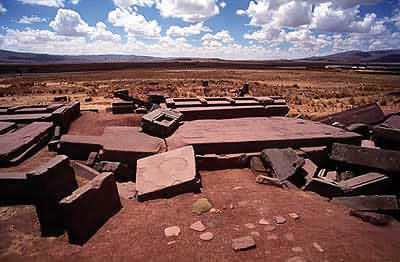
Puma Punku is a single part of the greater Tiahuanaco complex.The Puma Punku temple offers one of the best examples of masonry skills in the whole of the pre-Columbian Americas. Other incredibly carved temple complexes such as the Peruvian Inca walls of Sacsayhuaman, or the Inca masonry at Machu Pichu and Ollantaytambo pale to insignificance when compared with the sheer skill, accuracy and perfection achieved at Puma Punku.Today the site appears 'broken', and has been reduced to piles of scattered geometric blocks. These immense quartzite blocks were designed so as to interlock with each other, creating an architecturally unique temple without precedent in the America's. Puma Punku appears to have been destroyed by an earthquake, perhaps accompanied by a tidal wave from Lake Titicaca. Some of the structures on higher ground were once covered with 2 metres or so of earth. (9)According to Anthropology Professor W. H. Isbell, a radiocarbon date obtained from mound fill forming the Puma punku deposited during the oldest of three construction epochs dates the earliest construction epoch of the Puma punku at 1510 ±25 B.P. (A.D. 440; calibrated, A.D. 536–600). (6) This would place the building of the temple at the beginning of the third great Tiwanakan cultural expansion.
| Puma Punku: (The Door of the Puma) |
The Puma punku was an terraced earthen mound originally faced with megalithic blocks. It is 167.36 m wide along its north-south axis and 116.7 m long along its east-west axis. On the northeast and southeast corners of the Puma punku it has 20-meter wide projections that extend 27.6 meters north and south from the rectangular mound.The eastern edge of the Puma punku is occupied by what is called the “Plataforma Lítica.” The Plataforma Lítica consists of a stone terrace that is 6.75 by 38.72 meters in dimension. This terrace is paved with multiple enormous stone blocks. The Plataforma Lítica contains the largest stone slab found in both the Pumapunku and Tiwanaku Site.The largest of these stone blocks is 7.81 meters long, 5.17 meters wide, averages 1.07 meters thick, and is estimated to weigh about 131 metric tons. The second largest stone block found within the Puma punka is 7.90 meters long, 2.50 meters wide, and averages 1.86 meters thick. Its weight has been estimated to be 85.21 metric tons. (2)
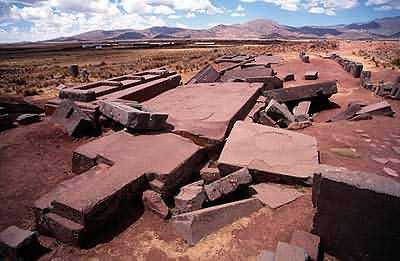

The quarry for these blocks was on the western shore of Titicaca, ten miles distant. (5)
Puma Punku was an emblem of the sacred mountain. A complex system of channels conducted rainwater from a sunken court on the summit into the interior of the pyramid, threading it from one terrace to the next. The water ultimately cascaded out from tunnels driven horizontally into the structure’s foundations.
The side walls of the water channels in the Akapana and at Puma Punku are built with upright stone slabs held together with I-shaped clamps. Protzen thinks this was to hold the slabs in the proper alignment. Clamps also once pieced together the enormous sandstone slabs used in the construction of the four platforms at Puma Punku. A unique feature at Puma Punku is the use of recessed clamping. The clamps used had a wide range of shapes and sizes, and the fact that the clamps are level even when the channel walls and the clamp sockets are at a slope of about 12° is usually interpreted to mean that they were cast directly into the sockets. A spectrographic analysis of a surviving clamp showed that it was made of an unusual alloy – 95.15% copper, 2.05% arsenic, 1.70% nickel, 0.84% silicon and 0.26% iron.
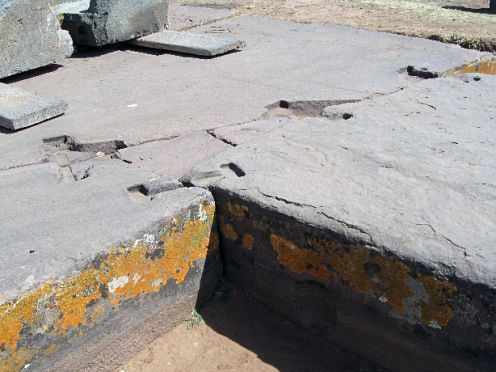
Other examples of 'Brick Ties' can be seen in the floor at Puma-punka. It is now believed that theses 'Ties' were made by pouring molten metal into the prepared holes. A portable smelter operating at extremely high temperatures would have been required for this purpose.
The I-shaped architectural cramps, which are composed of a unique copper-arsenic-nickel bronze alloy were used on a section of canal found at the base of the Akapana pyramid at Tiwanaku. These cramps were used to hold the blocks comprising the walls and bottom of stone-line canals that drain sunken courts. I-cramps of unknown composition were used to hold together the massive slabs that formed Puma punku's four large platforms. In the south canal of the Puma punku, the I-shaped cramps were cast in place. In sharp contrast, the cramps used at the Akapana canal were fashioned by the cold hammering of copper-arsenic-nickel bronze ingots. (8) The unique copper-arsenic-nickel bronze alloy is also found in metal artifacts within the region between Tiwanaku and San Pedro de Atacama during the late Middle Horizon around A.D. 600-900. (11)
Who Built Puma Punka.?
The Inca themselves denied building the Tiahuanacan complex. We now know that the Tiwanakan culture existed independently of the Inca, and from slightly before. A fact that is stored into their traditions and myths. The Inca origin myth records neary Lake Titicaca as the origin point of humanity. They record that Viracocha began his journey from this place, until following much wandering, Cuzco became chosen as the birthplace of the Inca nation.
'A story was told by the local Aymara indians to a Spanish traveller who visited Tiahuanaco shortly after the conquest spoke of the city's original foundation in the age of Chamac Pacha, or First Creation, long before the coming of the Incas. Its earliest inhabitants, they said, possessed supernatural powers, for which they were able miraculously to lift stones of off the ground, which "...were carried [from the mountain quarries] through the air to the sound of a trumpet'. (1)
It is theorised that the Puma Punku complex as well as its surrounding temples, the Akapana pyramid, Kalasasaya, Putuni and Kerikala functioned as spiritual and ritual centres for the Tiwanaku people. This area might have been viewed as the centre of the Andean world, attracting pilgrims from far away to marvel in its beauty. These structures transformed the local landscape; Puma Punku was purposely integrated with Illimani mountain, a sacred peak that the Tiwanaku possibly believed to be home to the spirits of their dead. This area was believed to have existed between heaven and Earth. The spiritual significance and the sense of wonder would have been amplified into a "mind-altering and life-changing experience" (12) through the use of hallucinogenic plants. Examinations of hair samples exhibit remnants of psychoactive substances in many mummies found in Tiwanaku culture mummies from Northern Chile, even those of babies as young as 1 year of age, demonstrating the importance of these substances to the Tiwanaku. (13)
NEWS: Indiegogo.com (Dec, 2013) Cosmogenic Dating of Megaliths at Puma Punku to take place.'Andesite megaliths in Puma Punku, will be evaluated by beryllium-10 cosmogenic dating to determine the prehistory date when the stone was quarried and machined'.
| The Sophisticated Masonry Skills at Puma Punku: |
The largest of the puma punku stone blocks is 7.81 meters long, 5.17 meters wide, averages 1.07 meters thick, and is estimated to weigh about 131 metric tons. The second largest stone block found within the Puma punku is 7.90 meters long, 2.50 meters wide, and averages 1.86 meters thick. Its weight has been estimated to be 85.21 metric tons. Both of these stone blocks are part of the Plataforma Lítica and composed of red sandstone (5). Based upon detailed petrographic and chemical analyses of samples from both individual stones and known quarry sites, archaeologists concluded that these and other red sandstone blocks were transported up a steep incline from a quarry near Lake Titicaca roughly 10 km away. Smaller andesite blocks that were used for stone facing and carvings came from quarries within the Copacabana Peninsula about 90 km away from and across Lake Titicaca from the Pumapunka and the rest of the Tiwanaku Site. (5)
Even though the site is two miles above sea level, the Tiwanakan builders managed to move stones, some weighing over 100 tons, for ten miles to get them into place. There is no evidence of the wheel in Tiwanakan culture, and there are no trees in the area to use as rollers. The feat of moving the stones for ten miles (let alone 90), is an incredible achievement in its own right.
It has been seriously suggested that there is evidence of basic machining at Puma-punka, as the following photo demonstrates:
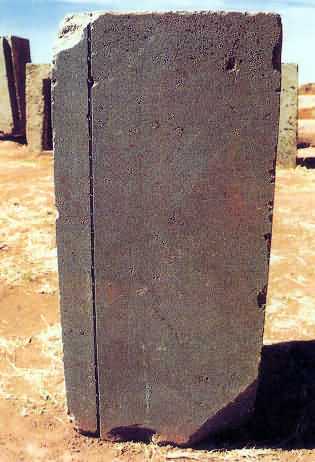
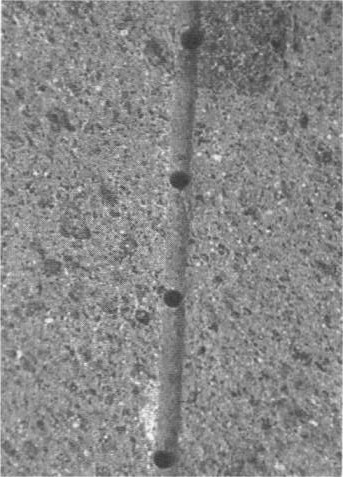
A close inspection of the stone above reveals that there are regularly spaced drill marks along the precision-cut 6mm groove.In the photo above, the same small drill holes can be seen in several areas where they appear to have been used as miniature 'pilot-holes', - perhaps in order to assist splitting the stone.The internal angles and faces of this stone were finished to 'machine' quality.
One of the most interesting things to have transpired about the site is that many of the immense blocks were built as if from a template, and amazingly appear to interlock as the picture below illustrates. Such a discovery flies directly in the face of all our concepts of the construction skills of the ancients. With no previous examples of masonry at such a sophisticated level, nor on such great scale leaves one to wonder at the confidence and skills of the designers and masons.
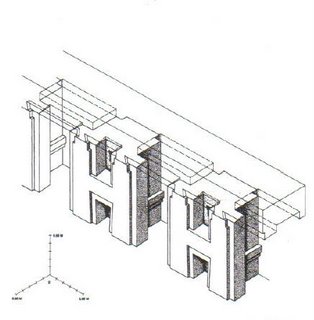
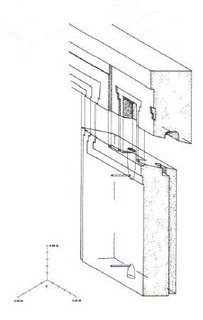
(Left) Illustrating the sophisticated way in which the Puma-punka stones fit together. (Right) A stone gateway from the Akapana pyramid shows the same modular feature. (3)
The numerous H-shaped blocks have approximately 80 faces on each. They all match each other with extreme precision suggesting that the architects used a system of preferred measurements and proportions.
| Puma Punku Gallery of Images: |
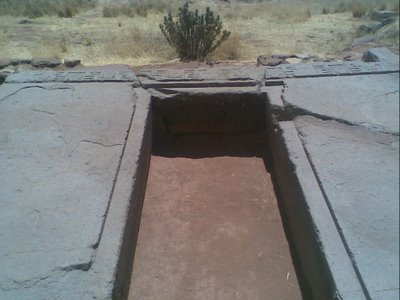
Fallen Stone Gateway. Similar in style to the 'Gateway of the Sun' at nearby Tiahuanaco.
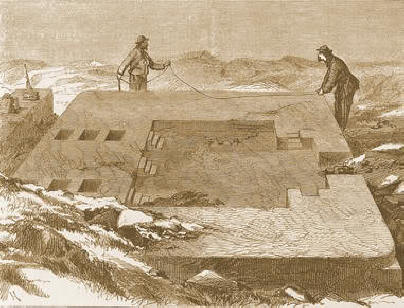
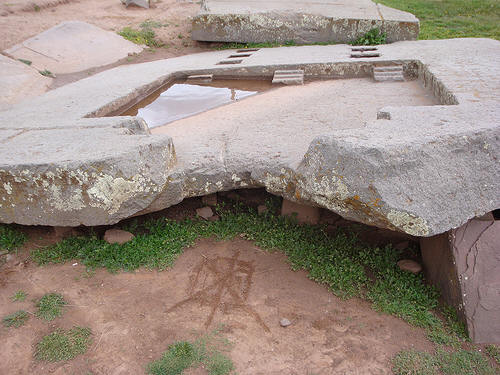
Drawing from 1877 (left), and recent photo (Right), of the same stone - although slightly more broken.
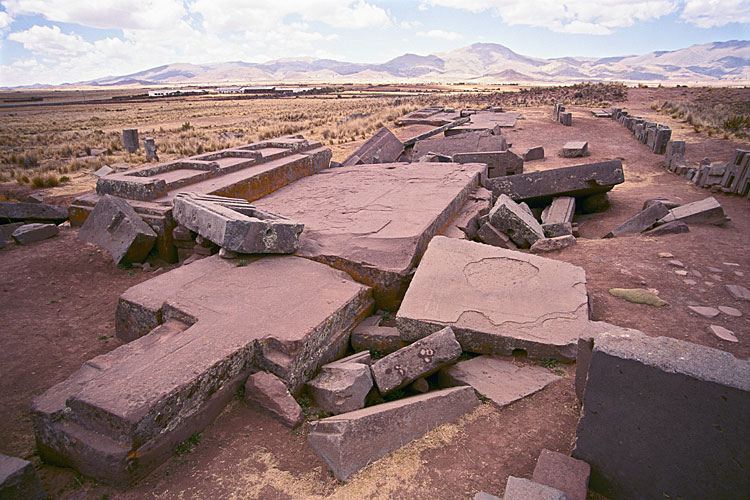
The 'Before' photo (pre-restoration)....

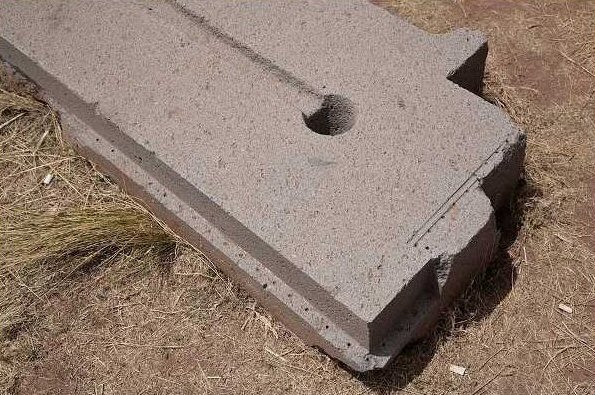
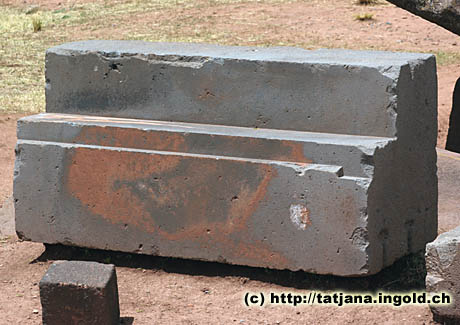
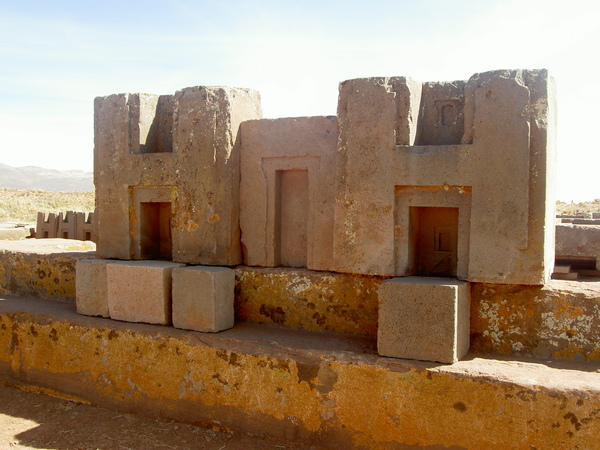
No comments:
Post a Comment